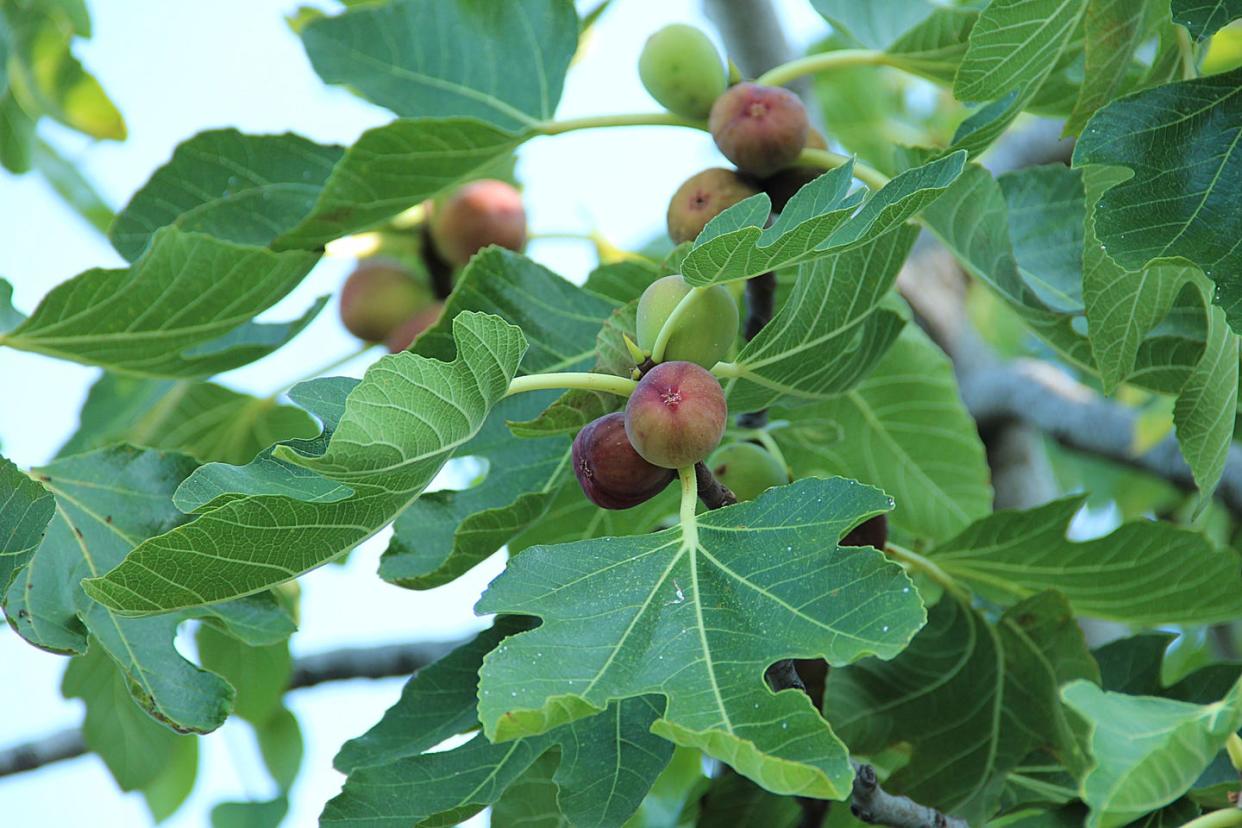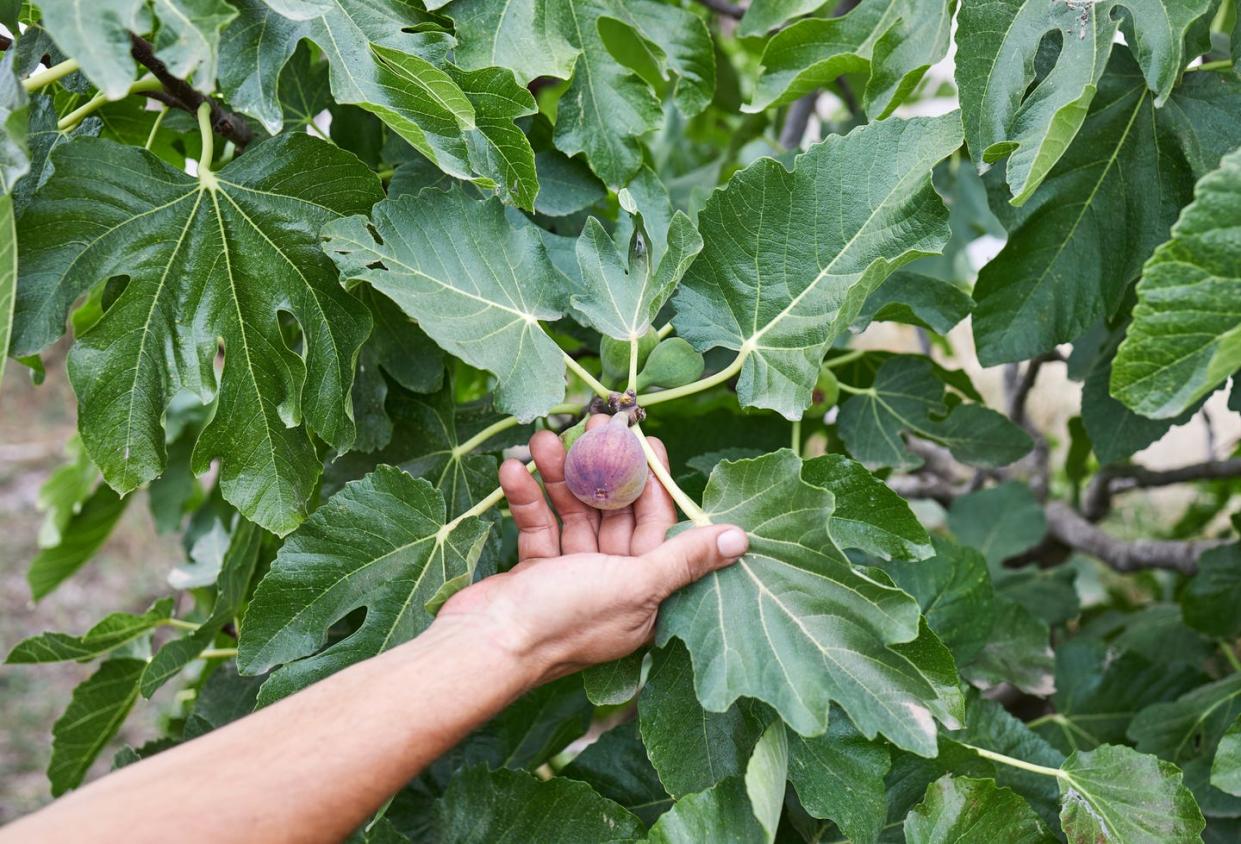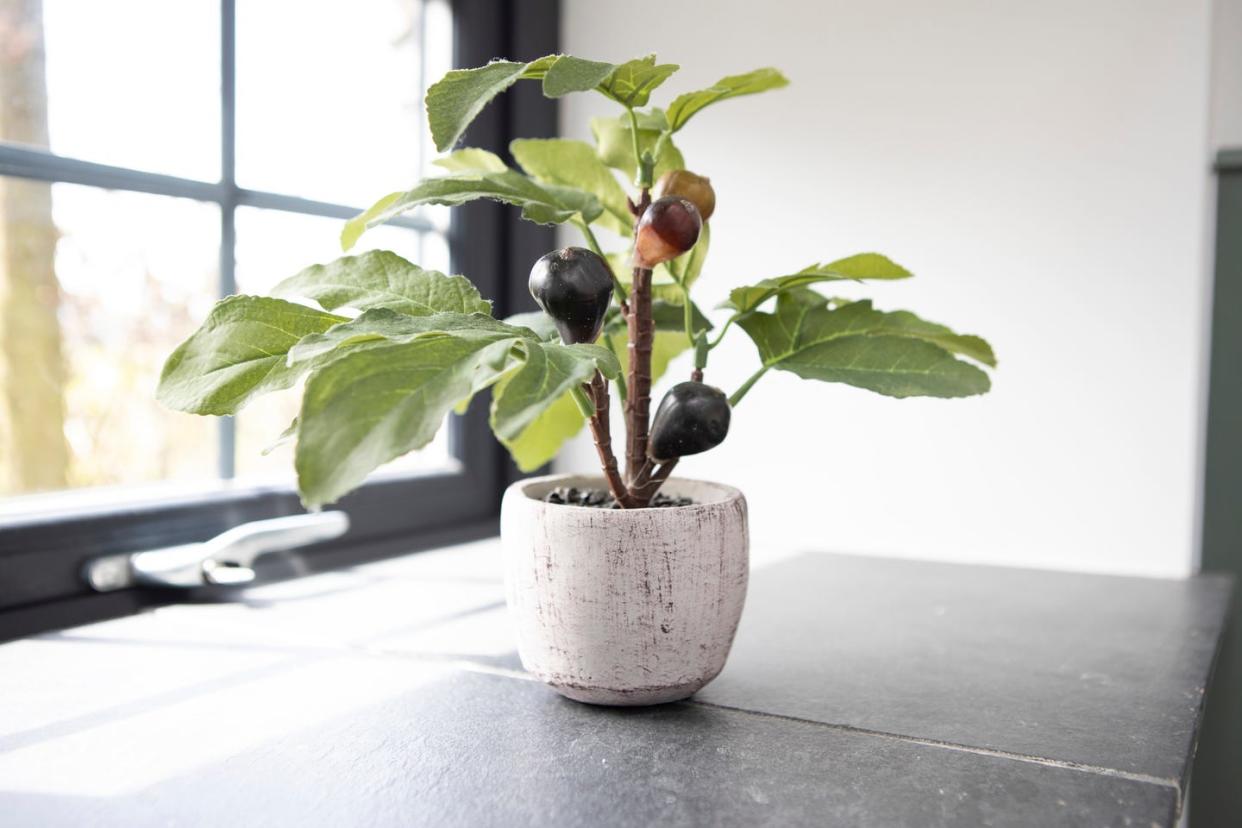Want to Grow Figs In Your Own Backyard? It's Easier Than You Think

"Hearst Magazines and Yahoo may earn commission or revenue on some items through these links."
There's a lot to love about fig trees—especially if you're lucky enough to have one in your own backyard. They have visually stunning lobed green leaves that can provide ample shade to neighboring low-light plants. Plus, they produce delicious fruit that you can eat right off the tree or bake into a favorite recipe.
Fig trees have plenty of other benefits, too. “From a functional point of view, fig trees are easy to prune with low water needs,” says Christian Douglas, an award-winning landscape designer and founder of the Marin, California-based Backyard Farm Company. “They are prolific producers in full sun, grow easily from cuttings, and do very well in a range of climate zones (if protected in cooler temps).”
Fig trees were first cultivated over 10,000 years ago—about 5,000 years earlier than olives and grapes. Today, as then, it’s not hard to grow your own at home. Here's everything you need to know about how to plant and care for fig trees.
Fig Tree Care
Fig trees are “very dependable and relatively easy to grow,” Douglas says, and when cared for properly, they'll yield a bountiful harvest of figs each year. This is what to keep in mind in terms of their care requirements.
Water
For the best-tasting fruit, Douglas recommends thoroughly watering your fig tree just once a week in the summer.
“Much like dry-farmed tomatoes, reducing water will avoid diluting sugars, creating sweeter fruits,” he adds. “If you are hoping for a bigger, more dense shade tree, then water it twice a week for the extra bushy foliage.”
Fertilizer
You'll want to fertilize your fig tree in the spring, just as the bud breaks, to ensure that it stays nourished throughout the growing season.
“I typically do a slow-release balanced fertilizer like EB Stone Citrus and Fruit Tree Food about two to three times from April to July,” he says.
Harvesting Figs

Since figs don’t ripen off the tree, only pick them when they’re soft to the touch. The skin is delicate, so be careful not to squish your fruit. If they stay firm, however, you could be facing another issue.
“If you’re finding your fig is setting fruit but they don’t ever quite ripen in time, then it’s likely not getting enough sun to develop the sugars,” Douglas says. “Remember that sun drives sugar production.”
While you're likely to get at least one harvest per year, in USDA Hardiness Zones 9 to 12, figs can fruit twice in the summer.
Pruning
Like most bushes, shrubs, and small trees, fig trees can benefit from being pruned early in the season.
“Spring is the best time for formative pruning of your fig trees,” Douglas says. “Typically about two weeks after the last frost.” If branches are obstructing pathways after rampant summer growth, you can prune those as needed. When pruning your fig tree, always wear long sleeves and gardening gloves because fig sap can irritate the skin.
Disease and Pest Problems
Fig trees can be susceptible to diseases and pests, so make sure to know the symptoms of these common issues.
Fig rust: This is a fungal disease that appears as brown and yellow spots on the leaves. To treat, make sure to remove and discard both fallen and diseased leaves and apply diatomaceous earth to the soil.
Blight: This is another fungal disease that can be contagious to your other plants if not treated in time. It is brought on by hot, humid weather and appears as yellow, watery spots on the leaves before turning them brown. Always remove and discard affected leaves.
Spider mites: These tiny bugs appear as small moving dots on the back of fig leaves, sucking up the nutrients from the leaf oils. Spray spider mites off with a powerful hose or, if the infestation is extensive, use insecticidal soap.
Mosaic fig virus (MSV): This infection, caused by spider mites, is identified by a pattern of light green splotches on the leaves. It can be rectified with rejuvenation pruning, which entails cutting back old branches.
When and Where to Plant a Fig Tree
The best time to plant fig trees is when they’re dormant, but timing also depends on your climate. Those who live in warmer regions should plant figs in the fall, but in colder areas, you want to plant your fig tree in the spring after the last frost.
Once established, fig trees will grow easily, but they need lots of sun. For this reason, you'll want to be strategic with where you plant it on your property.
“Mediterranean in origin, figs really prefer the heat,” says Douglas. “In cooler climates, a southwestern wall would be perfect. They lap up the extra warmth from the microclimate created.” Partial sun can work, he adds, but be prepared for it to produce less fruit. Figs also need a lot of elbow room to grow and should be planted 15 to 25 feet apart. Petite varieties only reach six to eight feet, but the Chicago hardy fig, for example, can grow up to 30 feet tall.
Another tip: Don’t plant fig trees too close to your house, or you risk damage to your foundation.
How to Plant a Fig Tree
If you've decided to get a fig tree from a plant nursery and have chosen the perfect, sunny spot for planting it, here are the steps to follow.
Dig a hole that’s a little larger and deeper than the root ball.
Add compost to the hole and mix well.
If it is a potted tree, gently remove it from the pot, place it in the hole, and backfill it with soil. For a bare root tree, be sure to soak the root ball in water for three hours before you plant it, so you can fan the roots out once your tree is in place.
Water deeply. Your new fig tree deserves a nice, long drink.
Fig trees can also be grown in pots—a good thing to know if you live in a colder climate. Douglas recommends using old wine barrels as planters, which are a good size and aesthetically pleasing.
“You can use a dolly to wheel them into a greenhouse or shed just before the heavy frost or snow in USDA Hardiness Zones 7 and below,” he says.

How to Propagate a Fig Tree
Once your fig tree is well established, you can make a plan to propagate it to add another tree to your property (or gift to a neighbor). Here's how to propagate a fig tree cutting.
When the tree is dormant in the winter, find a younger branch that’s about a centimeter wide. Take a cutting that’s about eight to ten inches long.
Cut the branch at a 45-degree angle and dip it in rooting hormone.
Place your cutting in a pot filled with compost and place it in a sunny spot.
Water frequently so the soil stays moist.
Fig Tree Types
There are hundreds of fig tree types, but these common varieties are some of the best for planting in different regions.
Black Mission Figs
“If I only plant one tree, then I typically go for the black mission,” says Douglas. “Its fruit is jammy, full of sugars and healthy antioxidants. The figs also have a reasonable shelf life and dehydrate really well.”
Recommended for USDA Hardiness Zones 7 to 9.
Adriatic Figs
With origins from the coastal regions of the Adriatic, these figs are suited to warm climates. Their skin is light green, and the flesh is known for its honeyed taste and is often used to make fig paste.
Recommended for USDA Hardiness Zones 7 to 9.
Brown Turkey
Unlike some fig trees, brown turkey figs thrive in colder climates and are often chosen for regions further north. Their figs have flavors of melon and honey.
Recommended for USDA Hardiness Zones 6 to 9.
Chicago Hardy
For a cooler climate zone, Douglas recommends Chicago hardy, which can survive soil temperatures of -20 degrees Fahrenheit (although some branches would die off). Flavor-wise, they have hints of cherry or strawberry.
Recommended for USDA Hardiness Zones 5 to 10.
Desert King
Despite what its name suggests, desert king fig trees don't do well in hot climates but can survive temperatures as cold as 5 degrees Fahrenheit. They grow quickly, but the fruit doesn't ripen until it turns pale yellow. Desert king figs are also known to be extra sweet.
Recommended for USDA Hardiness Zones 6 to 10.
Follow House Beautiful on Instagram and TikTok.
You Might Also Like
